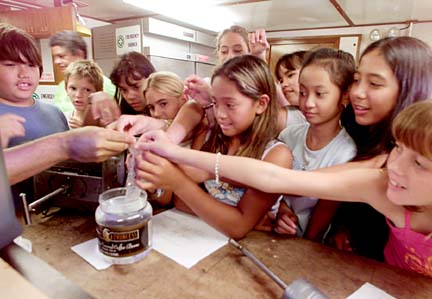
DENNIS ODA / DODA@STARBULLETIN.COM
The UH ship Ka'imikai-o-Kanaloa returned from a Northwest Hawaiian Islands expedition on Wednesday. They hosted schoolchildren yesterday on a tour of the ship and showed them what they were studying. Sunset Beach Elementary students were allowed to touch a jellyfish -- held by Ray Boland, a research biologist for the National Marine Fisheries Service -- that was displayed in one of the research labs aboard the ship.
Research dive yields
secrets of the deepA UH vessel with subs finds
new coral species and spots a
monk seal in the deep ocean
The Hawaii Undersea Research Laboratory submersible was perched on the side of a wall more than 1,600 feet below water collecting coral twigs when a visitor startled the three occupants.
CORRECTION
Thursday, Oct. 13, 2003>> A quote on Page A12 Saturday was mistakenly attributed to Terry Kerby, of the Hawaii Undersea Research Laboratory. It should have been attributed to Max Cremer.
The Honolulu Star-Bulletin strives to make its news report fair and accurate. If you have a question or comment about news coverage, call Editor Frank Bridgewater at 529-4791 or email him at fbridgewater@starbulletin.com.A Hawaiian monk seal swam by, peering curiously in each of the three submersible view-ports before moving on.
"It's the first time that ever happened," said Terry Kerby, HURL operations director and chief pilot. "No one has ever seen a seal that deep."
The seal encounter was one of the high points of a 64-day expedition in the Northwestern Hawaiian Islands that ended this week. The trip was sponsored by the National Oceanic and Atmospheric Administration.
The University of Hawaii's research vessel Ka'imikai-o-Kanaloa (Heavenly Searcher of the Seas) took a team of scientists from different institutions to investigate the deep ocean and its inhabitants.
The ship carries two submersibles, Pisces V and Pisces IV, that can operate down to 6,500 feet, a remotely operated vehicle (RCV-150) capable of working at 3,000-foot depths, and a Seafloor Sonar Mapping System.
DENNIS ODA / DODA@STARBULLETIN.COM
Le Jardin Academy students framed by pink coral tour a UH ship back from a Northwest Hawaiian Isles expedition.
Among discoveries, the scientists found 17 new species of corals, four new coral beds, beds with juvenile precious corals that have not been seen in the main Hawaiian islands, and dense coral and sponge communities at depths of 4,500 to 5,400 feet.
Kerby was piloting Pisces V with co-pilot Max Cremer and Amy Baco-Taylor, a UH graduate now with Woods Hole Oceanographic Institution, when the seal found them.
"It was a brutal dive," Kerby said, describing how he had to power the thrusters to hold the sub against the wall in a strong current.
Cremer took the thruster controls while Kerby collected coral samples with the sub's mechanical arm and put them in a jar in a specimen box. He also positioned a camera -- good timing because it was about then that Cremer saw a movement.
He thought it was a large fish, but a few seconds later it was looking into his view-port. "It was six inches away from me," he said. "Whoa, it's a monk seal!" he shouted.
"I was convinced I was the only one to catch a glimpse of it, and who would believe me?" he said. But it went on by the other two windows. "It was an unprecedented sighting, definitely the highlight of the expedition," Cremer said.
Baco-Taylor said she could see the whole body with the number A-12. It had been tagged last summer on Lisianski Island as part of the National Marine Fisheries Service's protected-species program.
Frank Parrish, fishery biologist with NOAA's Pacific Island Fisheries Science Center, was excited about the deep-ocean monk seal sighting because it was near a collection of gold corals. He had speculated that seals clustered over deep-ocean seamounts with corals, but none had been seen until now.
He said gold coral fluoresces when something brushes against it. "If an eel or other food source in coral is disturbed by a monk seal, the coral lights up, and that could be like ringing the dinner bell for a monk seal."
Three seamounts were surveyed by HURL scientists Chris Kelley and John Smith, Smithsonian coral specialist Stephen Cairns and Baco- Taylor.
Baco-Taylor said they saw such dense coral and sponge communities that rocks could not be seen underneath, and the sponges were 3 to 6 feet across. One was so large that the submersible hid behind it in strong currents, she said.
The scientists returned to the UH Marine Center at Sand Island Wednesday and discussed the voyage, the ship and their findings yesterday with about 255 third-, fifth- and seventh-graders.
The students -- from Le Jardin Windward Oahu Academy, Moanalua Middle School, Sunset Beach Elementary and Kalakaua Middle School -- watched videos from the trip and inspected samples of coral and critters brought back for study.
They also went on a scavenger hunt for marine-related items in an Ocean Education Fair under a tent near the research ship and filled out a form on what they learned.
"It was cool," said Samantha Tatum, fifth-grader at Le Jardin. "They go down eight hours, and they get to figure out things about the ocean."

